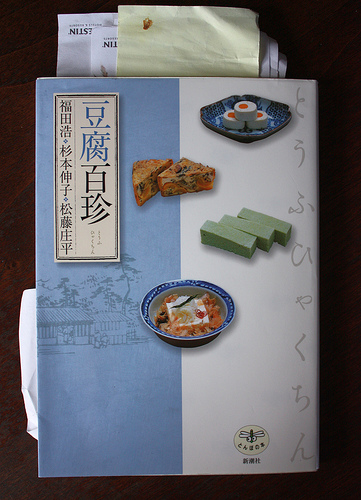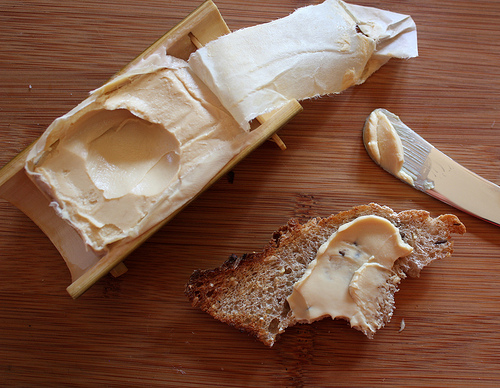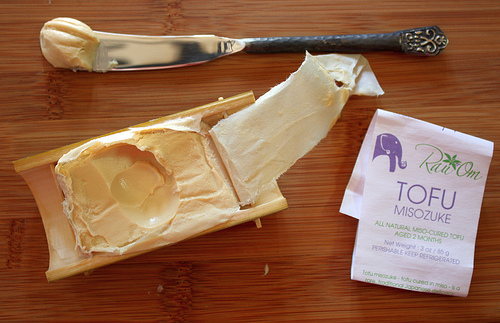Tofu is an extremely versatile food that can be manipulated in countless ways. A few months ago, Dang Vu emailed me about an unusual tofu product that he his wife, Oanh, had developed. The Vietnamese-American couple was selling tofu misozuke at Bay Area farmer’s markets, packaged under their company name, Rau Om (the name of a citrusy cuminy fresh herb also called ngo om; see the Viet herb primer for more info).
I’d read about the Japanese preserved “tofu cheese” in Elizabeth Andoh’s Washoku cookbook and seen it in Tofu Hyaku Chin, a 1782 bestseller in Japan. Alas, I hadn’t tasted it yet. It the world of Asian tofu, tofu no miso-zuke (how Elizabeth spelled it) is somewhat esoteric stuff. That is, a Japanese market or restaurant isn’t likely to have it.
I tried Rau Om’s tofu misozuke and found its meaty creaminess to be pleasant. Then I wondered why and how someone was introducing this rare tofu product to the Bay Area market. So I asked Dang, 32, to tell me a bit more about their background and endeavor.
He and Oanh, 29, have taken on the ancient preserved tofu product with vigor – even though Dang is finishing a doctorate program in molecular/cancer biology in Michigan and Oanh is a corporate strategy manager at Intuit in the Bay Area. They’re a long-distance couple with Ivy league credentials and a side passion for a food start-up. Both were born in Saigon and came to the States when Dang was 10 and Oanh was 16. They are accomplished at playing classical Vietnamese music and display a genuine appreciation for their elders. All that and they’re entrepreneurial too. (I am sure that my parents are reading this post with Viet pride and wishful thinking about their own children. It is unfortunately too late for me, Mom and Dad. ^_^)
Dang and Oanh’s achievements and tofu endeavor speak to the opportunities of living in America in the 21st century. Learn more about them and tofu misozuke below. My clarifications are in [brackets].
What is tofu misozuke?
A dish called misozuke tofu (miso-marinated tofu) has been around since the 13th Century We’ve had translated for us the tofu misozuke entry in a 1782 manuscript called Tofu Hyakuchin (豆腐百珍, 100 Tofu Delicacies). That said, most of what’s called tofu misozuke is usually aged overnight or up to a week. The version of tofu misozuke that we are producing have been aged for at least two months and can go to two years even. This version is a specialty of the Fukuoka region. When you cure tofu in miso for that long, the transformation is incredible - the texture is like a triple cream blue cheese or “a cross between butter and foie gras,” as a cheesemonger friend of ours put it.

Tofu misozuke is traditionally enjoyed straight, paired with sake or sochu. A small block, say a ¾” cube would be served with a cup of sake and one would savor very small pieces in between sips. That’s how we had tofu misozuke the first time in a sake bar while lost in Tokyo, and we were blown away. I mean, we’ve had all kinds of [fermented tofu] chao and tofu-ru before, tofu-yo from Okinawa, and stinky tofu, so we thought we had a pretty good idea of what tofu was capable of. But we were amazed and eating tofu misozuke straight, paired with sake or sochu, is still our preferred way to eat tofu misozuke. Of course, our customers here in the United States come from all over the world and we’ve had people tell us about their successful experiments with tofu misozuke paired with red wine and fresh or dried fruits, stuffed in olives, tossed in salad, served on grilled vegetables, etc...
Tofu misozuke is relatively obscure. Why do you make it?
It’s very simple - we fell in love with tofu misozuke at the very first taste and couldn’t get it again when we returned to the States. We asked at every Japanese restaurant or market we went to. We eventually found out when we blogged about our adventures that it was hard to find even in Japan.
We tried to find a recipe but we couldn’t, at least not one with the long curing time we had encountered. So we researched and pooled together all the resources and skills at our disposal: searching PubMed for relevant scientific literature, searching the web in English and Japanese (with the help of Google Translate), looking for an electronic copy of an 18th century recipe book on the National Diet Library website, looking for and begging someone to translate the recipe for us, and setting up numerous experiments. (For our technical references, see this page.) With a little bit of luck, and a lot of failures, we finally managed to make tofu misozuke like what we had in Japan.
We started sharing it and everyone (well, not our parents) told us we ought to sell it. We have an amazing, world-class deli in Ann Arbor where we were living, and we’re friends with a couple of the guys behind the cheese counter and they too were telling us we had something really really cool on our hands. So we knew we were onto something.

What have been the challenges and payoffs of developing misozuke tofu?
Tofu misozuke was really frustrating to get right. During those months of aging, tiny differences in prepping get amplified. The long curing process also means more time for things to go awry. Once we finally got a working recipe, we encountered other problems scaling up, all also related to the fact that tiny changes have big effects. We had more failures than we would like to remember in the last 3 years. But luckily, our experience in scientific research helped to immunize us to failures and to see each batch we had to throw away as a learning experience that narrowed down our options for what the best recipe might be.
The first payoff was of course that we had tofu misozuke to satisfy our cravings. It’s also been a thrilling new experience to be promoting and defending our work in the public. I’m supposed to do that with anything I discover in the lab, too, but this is way more direct. To sample a completely foreign food to strangers at the farmers markets and get the reactions we’ve been getting -- to see the amazement we felt in Tokyo reflected back -- that’s been a pretty heady experience and another wonderful payoff thus far.
The food business can be an iffy one. Why did you and Oanh decide to start one?
I guess a small part of it is that we wanted to see if we can’t build up something together. We have two activities that we both enjoy a lot. One is cooking, the other is music -- specifically classical Vietnamese music (nhạc tài tử...I am studying the moon lute (đàn kìm) and Oanh is studying the zither (đàn tranh). The latter is an even iffier business, even if we were talented. But mostly it’s because we have a great product on our hands, one that’s undeservedly obscure and we are positioned to try to correct that.
How do you select the foods that you produce? As Vietnamese Americans, why have you decided to produce Japanese foods?
The common thread between tofu misozuke and all-natural nem chua (Vietnamese terrine) [this is a type of tangy fermented raw sausage usually sold at the cash register of a Viet market] is that they’re both food we’re absolutely in love with but could not get anymore. Given our love of travelling and our curiosity to try anything we encounter along the way, our cravings don’t really have an ethnic boundary. The fact that we could not find a recipe for either, even given Internet search tools and access to literature, spurred us on to our research. And once we had a great recipe, we feel almost a responsibility to get it out there. [Rau Om also sells nem chua.]
We love tofu misozuke, and even in the absence of critiquing elders, we are still focused on making tofu misozuke exactly as we had it in Japan, and being respectful of that tradition. So on our first farmers market, it was unbelievably satisfying that a Japanese-American woman stopped by, tasted tofu misozuke and her jaw just dropped. “Oh my God, I haven’t had this in decades. My Grandma used to make it... this is exactly like what she used to make.” We’ve had a lot more positive feedback from people of Japanese descent since then, but most of them were along the line of “I can’t believe tofu misozuke is this delicious when you age it for months instead of days.” To run into someone from the right region of Japan who knew exactly what we were striving for on the very first day was pretty awesome.
How do you foresee the future of Rau Om?
We’ve already seen our product earn its traditional place at an izakaya here in the Bay Area, and conquer a new niche by being featured on cheese shelves at a specialty shop and a grocery store. We’d like to see more of that. We’d like Rau Om to remain an artisanal producer of unique delicacies, but one that’s able to get those delicacies into the hands of food lovers all over the country, or the world even!
For more information, check the Rau Om website. If you get a chance, taste Rau Om’s tofu misozuke. Dang said that he’s doing a tasting at Rainbow natural food co-op in San Francisco late this week.
If you’ve heard of or tasted tofu misozuke, share your experience and thoughts!


















Martin says
wow! and right here in the bay area! i can't wait to place an order and try this!
Linh-Dang says
Thank you so much, Andrea! For taking the time to check out Rau Om, and for researching tofu in general. I had no idea you could get a modern copy of Tofu Hyaku Chin - that could have saved us from having to find someone who could read 18th century Japanese! 🙂
Mai L. Libman says
This looks so amazing! How do I get some of this out in Boston?
Andrea Nguyen says
Hunting down Tofu Hyaku Chin was part of my field research for the "Asian Tofu" cookbook.
Linh-Dang says
Thanks, Mai. I grew up in Boston and would love to bring tofu misozuke back to my hometown, but right now people outside the Bay Area can only get tofu misozuke via mailorder from our website.
Michelle says
Wow! That sounds so delicious -- I need to track them down. And I can't help but be impressed at their stunning credentials. Bet their folks are proud of them! 🙂
diana says
Is there an update on which date they will be at Rainbow Grocery co-op? I couldn't find info on their website.
Thank you
Linh-Dang says
Hi Diana,
Thanks for enquiring. We'll be at Rainbow Grocery this weekend - Saturday Feb 11 and Sundat Feb 12 from 3pm to 7pm. Hope to see you there.
Asian love links says
Great stuff from you, man. Thanks a lot,Outstanding website. appreciate your dedication here.
KrisD says
Well, I was so inspired, I went right over to the online store! Looking forward to trying it.
Lynne says
I also am one who is hoping you'll be selling in the Boston area, Linh-Dang! It sounds so delicious. What a fascinating article - thank you, Andrea. Your site is always so interesting.
Oanh says
Thanks for posting this! It's too bad I saw the posting too late for the Rainbow Grocery tasting, but I'll definitely be on the lookout for Rau Om products. They sound delicious -- and I get the added benefit supporting fellow Viet-Americans in their endeavors!
Andrea Nguyen says
Oanh, maybe you can these folks at a Bay Area farmer's market!
JD says
Now that I have my own block of tofu misozuke, I can say that it's as delicious as described. If you like the flavor of miso, I think it's a slam dunk you'll enjoy this. Andrea says "meaty creaminess", I think that sums it up perfectly. I'm still not sure what niche it fills in my diet or eating habits, perhaps as a snack to be enjoyed while drinking with friends (as mentioned in the post), I'll have to bring it to the Toronado tonight.